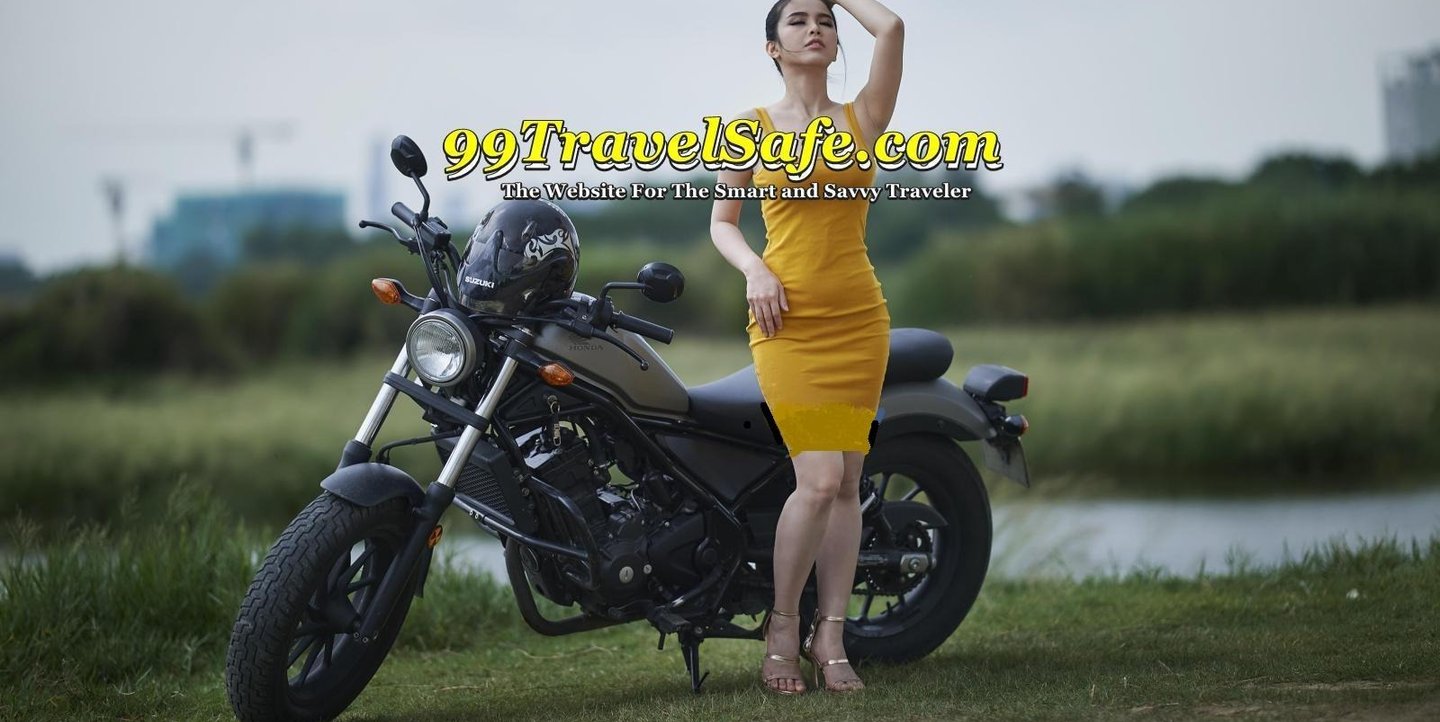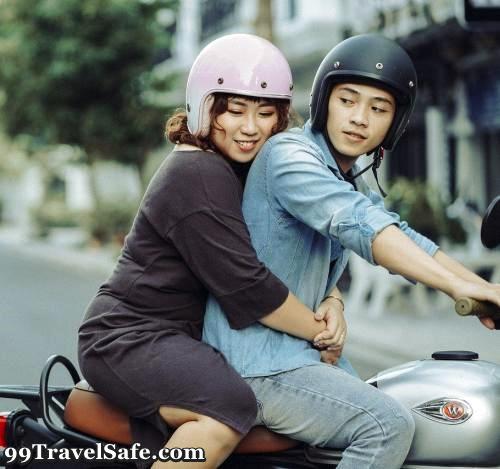

99TravelSafe.com
The Website For The Smart and Savvy Traveler
Motorcycle Riding Safety!


Related Pages - Please Also See;
90 – Bicycling Safety and Precautions
Motorcycle Riding Safety refers to the practices and precautions taken to protect the rider from danger while using motorcycles on the road. From rider behavior and protective gear to motorcycle maintenance and compliance with traffic laws. Following these practices can significantly reduce the likelihood of accidents and keep individuals safe on the road.
Things To Watch Out For;
Lack of Visibility
Motorcycles are smaller and more difficult to see than other vehicles, increasing their risk of collisions. Thus, other drivers are more likely to overlook them on the road, especially in blind spots or when changing lanes.
Road Conditions
Defects on the road surface pose safety hazards to motorcyclists. For example, potholes, uneven pavements, or oil spills can decrease traction on the road, resulting in accidents.
Distracted Driving By Car Drivers
Car drivers engaged in activities like texting, talking on the phone, or using in-car technology, are less likely to notice motorcycles and more likely to be involved in collisions. Failing to look at the road properly is the leading cause of motorcycle-related crashes in the United Kingdom.
Car Driver Negligence
Negligent actions from car drivers present a serious threat to the safety of motorcyclists. Crashes are more likely to occur when car drivers suddenly change lanes, run the red lights, or fail to yield right-of-way.
Car Driver Impairments
Car drivers under the influence of alcohol, drugs, or medications are more likely to get involved in accidents, as these conditions can give them reduced reaction time, diminished coordination, and impaired judgment.
Intersection Collisions
Intersections are common locations for accidents involving motorcycles. Motorists may misjudge the distance of motorcycles or their speed when turning left or crossing intersections.
High-Speed Collisions
Excessive speeding seriously increases the risk of accidents for motorcycle riders. The faster the vehicle goes, the lesser time riders have to react to impending hazards, and the gravity of the crash heightens.
Lack of Protective Gear
Failure to use protective equipment, such as helmets, pants, gloves, and boots, makes riders susceptible to head injuries, fractures, and abrasions.
Adverse Weather Conditions
Adverse weather conditions, such as rain, strong winds, fog, or snow, expose motorcyclists to additional hazards. Slippery surfaces, reduced visibility, and poor traction can compromise the safety of riders, especially if they aren’t careful.
Lack of Bike Rider Experience
Inexperienced motorcycle riders are more vulnerable to safety hazards due to poor judgment, improper control, and a lack of knowledge about safe riding practices.
Article Continues After Ads↓↓↓↓
Motorcycle Rider Risks
As a motorcyclist you are at higher risk of crashing when;
-- You are riding around a curve
-- You are at an intersection when you or another vehicle is turning right (left in some countries)
The most common causes of crashes involving motorcycles include;
-- Swinging wide on bends (leading to a head-on crash)
-- Pulling out to pass too quickly or cutting in after passing
-- Losing control of the motorcycle
-- Collisions at intersections with turning, side-on, merging and in-front traffic
-- Collisions with objects, such as parked cars.
Steps for Safe Riding;
-- Ride your own way! Don’t feel pressured to keep up with the group or ride beyond your ability – arriving in one piece is more important
-- Wear all the gear, all the time. Full protective gear including a helmet is your only protection in a crash.
-- Learn more about your motorcycle and gear
-- Make sure you ride sober and rested
-- Take corners slow and accelerate out when you can see that the exit is clear.
Ride with your headlight on dip (low beam) during the day to make you and your motorcycle more noticeable
-- Keep your distance! If someone makes a mistake or you spot a hazard, space gives you time to react and somewhere to go
Ride defensively always!
Ride to the conditions.
Article Continues After Ads↓↓↓↓
Motorcycle Riding in Bad Weather
-- Check the weather forecast
-- Ride below the speed limit
-- Check for any closures, delays or warnings on your route and plan your journey and rest stops to manage fatigue.
Use Waterproof Clothing
Invest in a good quality waterproof jacket and pants, or consider a poncho for flexibility.
Layering
Wear layers to stay warm and dry, including a base layer, insulation, and a waterproof outer layer.
Use Gloves and Overshoes
Protect your hands and feet with waterproof gloves and overshoes.
Headwear
A Helmet all the time!
Reflective Gear
Wear bright, reflective clothing and use lights to enhance visibility, especially in low light conditions.
Mudguards
Install mudguards to prevent water and debris from splashing up and keeping you and your bike cleaner.
Prepare Your Bike
Tire Pressure
Check your tire pressure and ensure they are in good condition, as they are your only contact points with the road.
Brakes
Ensure your brakes are working properly and are adjusted for wet conditions.
Chain and Drivetrain
Regularly clean and lubricate your chain and drivetrain to prevent rust and wear.
Weatherproof Your Bike
Consider using a bike cover to protect your bike from the elements when storing it.
Riding Techniques for Bad Weather:
Reduce Speed
Be extra cautious and reduce your speed, especially on wet roads, as braking distances will be longer.
Avoid Puddles
Be aware of puddles and try to avoid them, as they can hide potholes or other hazards.
Be Aware of Wind
Be aware of the wind and adjust your riding style accordingly, as strong winds can make it difficult to control your bike.
Stay Near Shelter
If the weather deteriorates, look for shelter or consider turning around.
Change Route If Necessary:
If the weather is bad and you are on a route that is not safe, change your route to a safer one.
Do Not Fight the Wind!
Don't push too hard when riding into a headwind, focus on maintaining a sustainable effort rather than speed.
Use Engine Braking
Use engine braking along with your brakes to slow down and maintain control
Post-Ride Care
Dry Your Bike
After a ride in the rain, dry your bike thoroughly and pay close attention to bolts and the drivetrain.
Clean Your Bike
Regularly clean your bike to remove dirt and grime, especially after riding in wet conditions.
Pack Dry Clothes
Always pack a change of dry clothes for post-ride comfort.
Article Continues After Ads↓↓↓↓
Finally, All Bike Riders Must Always Remember To;
Wear Protective Gear
Using protective gear is the single most effective way to protect yourself on the road. Donning the appropriate helmet, gloves, jacket, pants, and boots greatly reduces the impact of falls and collisions on your body and safeguards you from head injuries, burns, fractures, and abrasions.
Make sure to choose protective gear that meets safety standards (e.g., Federal Motor Vehicle Safety Standard) and fits you properly.
Observe All Traffic Laws
Another great way to be safe on the road is by following traffic laws and regulations in your area. Pay attention to the speed limit, turn signals, and traffic lights as you navigate the roads. Doing so is vital not only for your safety but also for the safety of other drivers.
To learn more about traffic and road safety regulations, make sure to check the website of your local, state, or national authorities.
Develop Defensive Riding Skills
Defensive riding skills are a must for any motorcycle rider, as it helps them anticipate and avoid potential hazards on the road. Not only does it lower the chances of crashes, but it also reduces maintenance and repair costs resulting from these accidents.
Here are a few tips to help you enhance this skill;
-- Stay focused on the road
-- Be aware of your surroundings
-- Watch out for pedestrians on the road
-- Maintain a safe distance from other vehicles
-- Anticipate the actions of other drivers
-- Use turn signals to alert other drivers of your movement.
-- Check your blind spots before changing lanes or making turns.
Perform Regular Maintenance and Inspections
Inspections and maintenance help keep your motorcycle in good condition and ensure it’s safe to use. Periodically carrying them out reduces the risk of mechanical failures that can result in avoidable accidents.
Before each ride, make sure to check the brakes, tires, lights, and other critical components. Riders can use a digital vehicle inspection checklist when going through these parts to make sure that no item is overlooked.
Create Your Own Vehicle Inspection Checklist
Finally, Ride Within Your Limits!
Lastly, self-awareness is crucial for motorcycle safety on the road. It is important to know your riding capabilities and stay within your limits. For example, if you have ingested alcohol or taken medication, it is best to refrain from driving.
Furthermore, if you’re new to motorcycle riding, it’s recommended to avoid taking unnecessary risks or trying maneuvers beyond your skill level. Instead, you can gradually push your limits as you gain more experience.
